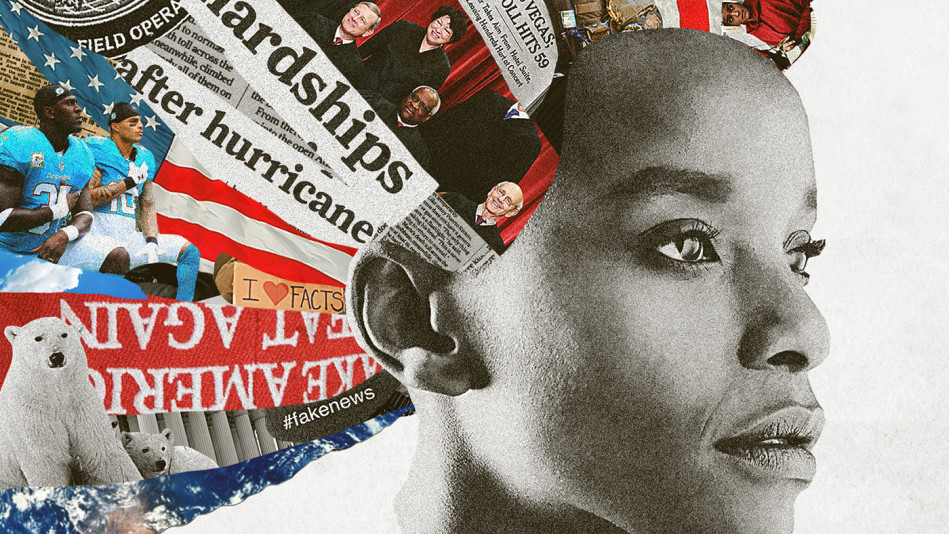How Curiosity Fights Fear and Connects Us All
As a contributor to two podcasts from the fun-facts website HowStuffWorks—FoodStuff and BrainStuff—Lauren Vogelbaum has learned there's nothing trivial about having an inquiring mind.

Illustration: Lincoln Agnew. Photos: Woman, bears, hat, NFL, justices: Getty Images. Customs, Vegas, soldier: Alamy. Fake news, facts: Zumapress. Flag: Stephen St. John/National Geographic Creative. Puerto Rico: San Francisco Chronicle/Polaris. Handmaids: George Kraychyk/Hulu.
Assumptions are foolish at best. Throughout history, so many great discoveries happened because someone challenged their preconceptions. For hundreds of years, Europeans were terrified of tomatoes because they were thought to be toxic. If one brave person hadn't dared to try them, we'd be living in a world without pizza!
Fighting preconceptions is even more important when it comes to people. Health research has taught me that while similarities exist across certain groups, every person's system responds in its own unique way to everything she experiences. You can't assume you know someone just because of a demographic, like religion or race. People are beautiful mysteries.
Curiosity also fights fear. My father was recently diagnosed with Creutzfeldt-Jakob, a fatal degenerative brain condition that's related to mad cow disease. Shortly after his diagnosis, I was looking into the dairy industry for a FoodStuff episode on yogurt, and it led me to research the mad cow scare of the '90s and early 2000s. It was frightening to read about the disease, but also comforting to deal with hard facts instead of a big, terrifying unknown. Whenever I'm facing something scary that I'd like to shy away from, I try to do the opposite and delve right in.
In my crazy dream job of researching cool stuff, I've come to understand how much questions connect us. Every single object around us is the result of millennia of human innovation, and every single person who's touched it has her own story. Take the plastic your phone is made of. If you investigate, you realize it's a petroleum product that was once a fossil, which was once a living thing. It could have been a palm tree or a dragonfly or a tyrannosaurus millions of years ago, and now it's your cell phone cover—and it's someone's job to make the molds that produce it. That's so wild! It never fails to blow my mind. It's like that old Carl Sagan quote: We really are starstuff.
Assumptions are foolish at best. Throughout history, so many great discoveries happened because someone challenged their preconceptions. For hundreds of years, Europeans were terrified of tomatoes because they were thought to be toxic. If one brave person hadn't dared to try them, we'd be living in a world without pizza!
Fighting preconceptions is even more important when it comes to people. Health research has taught me that while similarities exist across certain groups, every person's system responds in its own unique way to everything she experiences. You can't assume you know someone just because of a demographic, like religion or race. People are beautiful mysteries.
Curiosity also fights fear. My father was recently diagnosed with Creutzfeldt-Jakob, a fatal degenerative brain condition that's related to mad cow disease. Shortly after his diagnosis, I was looking into the dairy industry for a FoodStuff episode on yogurt, and it led me to research the mad cow scare of the '90s and early 2000s. It was frightening to read about the disease, but also comforting to deal with hard facts instead of a big, terrifying unknown. Whenever I'm facing something scary that I'd like to shy away from, I try to do the opposite and delve right in.
In my crazy dream job of researching cool stuff, I've come to understand how much questions connect us. Every single object around us is the result of millennia of human innovation, and every single person who's touched it has her own story. Take the plastic your phone is made of. If you investigate, you realize it's a petroleum product that was once a fossil, which was once a living thing. It could have been a palm tree or a dragonfly or a tyrannosaurus millions of years ago, and now it's your cell phone cover—and it's someone's job to make the molds that produce it. That's so wild! It never fails to blow my mind. It's like that old Carl Sagan quote: We really are starstuff.



